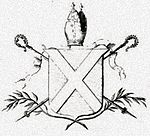Máel Ísu II (bishop of the Scots)
- Máel Ísu II (bishop of the Scots)
-
Máel Ísu II is the sixth alleged Bishop of Cennrígmonaid, equivalent to later day St. Andrews. He is mentioned in the bishop-lists of the 15th-century historians Walter Bower and Andrew of Wyntoun as the successor of Cellach II.[1] We have no direct dates for Máel Ísu II's episcopate, but the indirect evidence for his predecessors suggests that he was bishop in the later 10th and/or early 11th century.[2]
Notes
- ^ John Macqueen, Winifred MacQueen, & D.E.R. Watt, (eds.), Scottichronicon by Walter Bower in Latin and English, Vol. 3, (Aberdeen, 1995), pp. 344-5, 463, where the translators wrongly translate his name, given in the Latin as Malisius, as "Maelbrigde"; see also, Andrew of Wyntoun, The Original Chronicle, line 1494, which calls him "secund Malice", available online here
- ^ see articles on Fothad I, Máel Ísu I, Cellach II and Máel Muire.
References
- MacQueen, John, MacQueen, Winifred & Watt, D.E.R. (eds.), Scottichronicon by Walter Bower in Latin and English, Vol. 3, (Aberdeen, 1995)
External links
| Religious titles |
Preceded by
Máel Muire |
Bishop of the Scots
fl. late 900s/early 1000s |
Succeeded by
Ailín |
| v · Bishops and Archbishops of St Andrews |
|
| Known Pre-Conquest Bishops |
|
 |
|
| Post-Conquest Bishops |
|
|
| Pre-Reformation Archbishops |
|
|
| Post-Reformation Archbishops |
|
|
|
|
|
Categories:
- 10th-century births
- 980s deaths
- Bishops of St Andrews
- Medieval Gaels
- 10th-century bishops
- 11th-century bishops
Wikimedia Foundation.
2010.
Look at other dictionaries:
Máel Ísu I (bishop of the Scots) — Máel Ísu I is the third alleged Bishop of Cennrígmonaid (fl. mid 10th century), equivalent to later day St Andrews. He is mentioned in the bishop lists of the 15th century historians Walter Bower (Malisius) and Andrew of Wyntoun (Malice) as the… … Wikipedia
Máel Muire (bishop of the Scots) — Máel Muire is the fifth alleged bishop of St Andrews, though at that period the bishop of the Scots did not necessarily have one episcopal seat. He is mentioned in the bishop list of the 15th century historian Walter Bower as the successor of… … Wikipedia
Máel Dúin (bishop of the Scots) — Máel Dúin (died 1055) is the eighth alleged Bishop of St Andrews (or Cennrígmonaid). He is mentioned in the bishop lists of the 15th century historians Walter Bower and Andrew of Wyntoun as the successor of Bishop Ailín.[1] Fortunately, Máel Dúin … Wikipedia
The Celtic Rite — The Celtic Rite † Catholic Encyclopedia ► The Celtic Rite This subject will be treated under the following seven heads: I. History and Origin; II. Manuscript Sources; III. The Divine Office; IV. The Mass; V. the Baptismal Service; … Catholic encyclopedia
Scotland in the High Middle Ages — The history of Scotland in the High Middle Ages covers Scotland in the era between the death of Domnall II in 900 AD and the death of king Alexander III in 1286, which led indirectly to the Scottish Wars of Independence.In the tenth and eleventh… … Wikipedia
England and King David I — The relationship between the Kingdom of England and King David I, who was King of Scotland between 1124 and 1153, was partly shaped by David s relationship with the particular King of England, and partly by David s own ambition. David had a good… … Wikipedia
Celtic Rite — The term Celtic Rite is generally, but rather indefinitely, applied to the various rites used in Great Britain, Ireland, perhaps in Brittany, and sporadically in Northern Iberia, and in the monasteries which resulted from the Irish missions of St … Wikipedia
David I of Scotland — David I King of the Scots ... (more) Reign April or May 1124 – 24 May 1153 Coronation Scone, April or May 1124 … Wikipedia
David Beaton — His Eminence David Cardinal Beaton Cardinal Archbishop of St Andrews Archdiocese … Wikipedia

